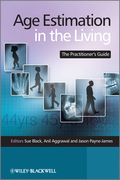
Age estimation in the living: the practitioner's guide
Black, Sue
Aggrawal, Anil
Payne-James, Jason
This book summarizes and explains the main approaches to age estimation in the living, defining when a parameter may be of use and raising awareness of itslimitations. This text ensures that practitioners recognize when an assessment is beyond their area of expertise or beyond verification depending upon the clinical data available. Each key approach to age evaluation has been allotteda single chapter, written by an international leader in the particular field.The book also includes summary chapters that relay readily accessible data for use by the practitioner, and includes important ageing milestones INDICE: Foreword. Preface. Glossary of Abbreviations. 1 An Introduction tothe History of Age Estimation in the Living (Andreas Schmeling and Sue Black). 1.1 Introduction. 1.2 Dental Development. 1.3 Skeletal Maturation. 1.4 Secondary Sexual Development. 1.5 Conclusion. References. 2 Immigration, Asylum Seekers and Undocumented Identity (Heather Law, Lorraine Mensah, Sue Bailey and Julia Nelki). 2.1 Asylum Seeker to Refugee. References. 3 Clinical and Legal Requirements for Age Determination in the Living (Philip Beh and Jason Payne-James). 3.1 Introduction. 3.2 Contrasts between Age Assessment in the Living and the Deceased. 3.3 Reasons for Age Estimation of Bodies and Human Remains. 3.4 Reasons for Age Estimation of Living Individuals. 3.5 Assessment Techniques. 3.6 How Age May Be Specifically Documented. 3.7 Birth Certificates. 3.8 Identity Cards. 3.9 Driving Licence. 3.10 Passports. 3.11 Age Verification Cards. 3.12 Other Documents. 3.13 Medical Issues. 3.13.1 Duties to Examinee. 3.14 Communication. 3.15 Summary and Conclusions. References. 4 Legal Implications of AgeDetermination: Consent and Other Issues (George Fernie and Jason Payne-James). 4.1 Introduction. 4.2 Principles of Practice. 4.3 Duties of the Examining Practitioner. 4.4 Criminal Issues in Age Determination in the Living. 4.5 Practical Implications. 4.6 Summary. References. 5 The Challenges of Psychological Assessments of Maturity (Julia Nelki, Pete Grady, Sue Bailey and Heather Law). 5.1 Introduction. 5.1.1 Current Status in the UK. 5.2 Need for Determination of Maturity. 5.3 Psychological Maturity as a Concept. 5.3.1 Child Development. 5.3.2 Middle Childhood. 5.3.3 Adolescence. 5.3.4 Ethical Framework. 5.4 Current Practice. 5.5 Suggestions for a Framework for Good Practice. 5.5.1 Setting. 5.6 Summary and Conclusion. Appendix 5.A Proposed Framework, Based on Common Assessment Framework (Department of Schools Families and Children, 2007). References. 6 Principles of Physical Age Estimation (Sue Black and George Maat). 6.1 Intra-uterine Growth and Development. 6.2 Birth and Infancy. 6.3 Childhood. 6.4 Juvenile. 6.5 Adolescence. 6.6 Adult. 6.7 Senescence. 6.8 Summary. 6.9 Growth Studies. References. 7 Growth, Maturation and Age (Noel Cameron and Laura L. Jones). 7.1 Growth, Maturation and Age. 7.1.1 The Concept of Time. 7.1.2 Maturity Indicators. 7.1.3 Maturational Variation. 7.1.4 Uneven Maturation. 7.1.5 Sexual Dimorphism. 7.1.6 Maturity and Size. 7.2 Assessment of Maturation. 7.2.1 Skeletal Maturity. 7.2.2 Dental Maturity.. 7.2.3 Secondary Sexual Development. 7.2.4 Independence of Methods. 7.3 Secular Trends. 7.4 Worldwide Variation in the Timing of Maturation. 7.4.1 Secondary Sexual Development. 7.4.2 Dental Development. 7.4.3 Skeletal Development. 7.5 Factors Associated with the Timing of Maturation. 7.5.1 Genetic Variability. 7.5.2 Demographic Factors. 7.5.3Biological Factors. 7.5.4 Environmental Factors. 7.6 Summary. References. 8 Practical Imaging Techniques for Age Evaluation (Andreas Schmeling, Sven Schmidt, Ronald Schulz, Andreas Olze, Walter Reisinger and Volker Vieth). 8.1 Introduction. 8.2 Radiation Exposure in X-ray Examinations for the Purpose of Age Estimation. 8.3 Radiological Examination of the Hand. 8.4 Radiological Examination of the Teeth. 8.5 Radiological Examination of the Clavicles. 8.6 Summary and Conclusions. References. 9 External Soft Tissue Indicators of Age from Birthto Adulthood (Anil Aggrawal, Puneet Setia, Avneesh Gupta, and Anthony Busuttil). 9.1 Growth Patterns. 9.2 Anthropometric Parameters in Children. 9.2.1 Growth Charts. 9.2.2 Developmental Milestones. 9.3 Pubertal Changes. 9.3.1 Stages of Pubic Hair Development Derived from Tanner (1962). 9.3.2 Stages of AxillaryHair Development Derived from Tanner (1962). 9.3.3 Stages of Development of Male Genitalia Derived from Tanner (1962). 9.3.4 Stages of breast development as derived from Tanner (1962). 9.3.5 Age of Menarche. 9.4 Areas of New Research. 9.5 Conclusion. References. 10 Age Evaluation and Odontology in the Living (Jane Taylor and Matthew Blenkin). 10.1 Introduction. 10.2 Overview of the Development of the Dentition. 10.3 Techniques of Dental Age Estimation. 10.4 The Sub-adult Dentition. 10.4.1 Sub-adult: Physical/Anatomical. 10.4.2 Sub-adult: Radiographic. 10.4.3 Sub-adult: Destructive. 10.5 The Adult Dentition. 10.5.1 Adult: Physical. 10.5.2 Adult: Radiographic. 10.5.3 Adult: Destructive. 10.6 Summary. References. 11 Age Evaluation from the Skeleton (S. Lucina Hackman, Alanah Buck and S. Black). 11.1 Background. 11.2 Fetal Age. 11.3 Birth. 11.4 Juvenile/Child. 11.5 Age Estimation from the Skeleton in Living Adults. 11.6 Medial Clavicle. 11.7 Sternal Ribs and Costal Cartilages. 11.8 Pelvis. 11.9 Skull Sutural Closure. 11.10 Laryngeal Cartilages. 11.11 Other General Ageing Features. 11.12 Summary. References. 12 Age Evaluation after Growth Cessation (Anil Aggrawal, Puneet Setia, Avneesh Gupta and Anthony Busuttil). 12.1 Background. 12.2 Consent. 12.3 Radiology. 12.3.1 Pubic Bones. 12.3.2 Long Bones. 12.3.3 Skull Sutures. 12.3.4 Costal Cartilages. 12.3.5 Vertebrae. 12.3.6 Laryngeal Cartilages. 12.4 Odontology. 12.5 Soft Tissues of Face. 12.6 Genetics in Age Estimation. 12.7 Physiological and Biochemical Parameters for Age Estimation. 12.8 Areas of Future Research. 12.8.1 Small Long Bones. 12.8.2 Scapula. 12.8.3 Others. 12.8.4 Histology. 12.9 Conclusion. References. 13 The Presentation of Results and Statistics for Legal Purposes (David Lucy). 13.1 Introduction. 13.2 Evidence and Intelligence. 13.3 Statistical Methods in Age Estimation. 13.4 Classical, or Frequentist, Approaches. 13.5 Bayesian Approaches. 13.6 The Relevanceto Age Estimation. 13.7 Likelihood Ratio Approaches. 13.8 Errors of Interpretation. 13.9 Concluding Comments. Appendix 13.A Age-Related Data from Gustafson(1950). References. 14 Key Practical Elements for Age Estimation in the Living (Sue Black, Jason Payne-James and Anil Aggrawal). 14.1 The Four Pillars of Age Estimation. 14.1.1 Pillar 1: Social and Psychological Evaluation. 14.1.2 Pillar 2: External Estimation of Age. 14.1.3 Pillar 3: Skeletal Estimation of Age. 14.1.4 Pillar 4: Dental Estimation of Age. 14.2 Conclusion. Index.
- ISBN: 978-0-470-51967-7
- Editorial: John Wiley & Sons
- Encuadernacion: Rústica
- Páginas: 320
- Fecha Publicación: 08/10/2010
- Nº Volúmenes: 1
- Idioma: Inglés
